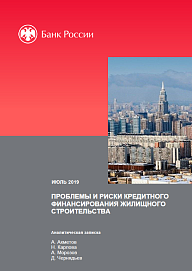Increase in housing construction
The Bank of Russia has published an analytical note where it assesses the feasibility of a massive increase in housing construction and studies problems, risks, and possible consequences of such an expansion in construction capacities. The Housing and Urban Environment national project stipulates an increase in housing construction to 120 million square meters per year by 2024, including 80 million square meters in apartment buildings per year, of which 53 million square meters per year must be financed by mortgage lending.
The authors of the publication point out that such a rapid growth in the sector means that investment in housing construction will have to be increased to 3.0% of GDP in 2024. Meanwhile, the highest ever value of this indicator (2.9% of GDP) was observed during the construction boom in 2008 and brought about a range of financial problems. This is why, to assess the possibility of attaining the 3% figure, it is essential to do an all-round analysis of demand and supply on the housing market, as well as of the factors that affect them.
Supply-related constraints in construction
When analysing the supply on the construction market, the authors single out low creditworthiness of the sector as one of the key problems in the process of transition to project financing. For example, according to DOM.RF, only 64% of projects would qualify for receiving bank financing, while others have either a «low» or a «satisfactory» level of creditworthiness. The publication stresses the importance of arranging a fast and painless exit from the market for a large number of inefficient and insolvent construction companies (which means that it will be necessary to finish the construction projects they have started). Also, sufficient financing (including bank financing) will have to be provided to solvent developers after the transition to escrow accounts.
Demand-related constraints in construction
The authors state that demand-related constraints in the sector stem from the level of the need for housing conditions improvement, the current housing demand structure, and the availability of financial resources for this. A mismatch between supply and demand is fraught with potential problems for the market — either a rapid growth of housing prices (if demand exceeds supply) or a drop in prices (if demand is insufficient).
Therefore, the authors single out a number of factors for a steady growth in the mortgage lending market. These factors will mitigate financial risks for both banking institutions and the public. They are:
1) a steady growth in household income;
2) redistribution of debt load of the population from non-mortgage to mortgage loans;
3) a greater average life cycle of mortgage loans;
4) lower loan rates.
Trends on the housing construction market
The analytical note also reviews a number of trends which indicate that the planned increase in housing construction is fraught with risks, so the growth rates might turn out to be lower than expected. These trends include limited construction capacities, a lag between new housing supply and mortgage programs development in some regions, and a decrease in housing commissioning despite the mortgage development. In 2018, for example, housing commissioning volume was 75.3 million square meters, which is 4.9% less than in 2017, and 6.1% less than in 2016. This resulted from a decrease in commissioning of apartment buildings and individual houses.
Conclusions
The authors conclude that to overcome the constraints in demand and supply it is necessary to develop a set of measures aimed at the following:
- rehabilitating the construction sector and improving its financial and credit stability;
- reducing regulatory load and simplifying access to infrastructure;
- adopting a structural policy in demand;
- improving the investment climate.






